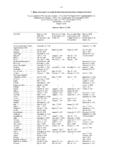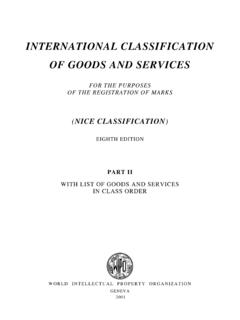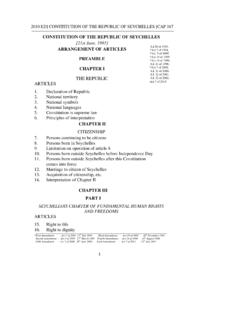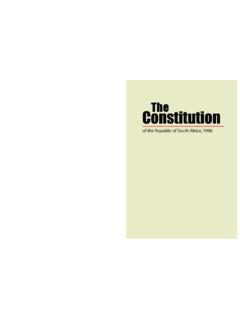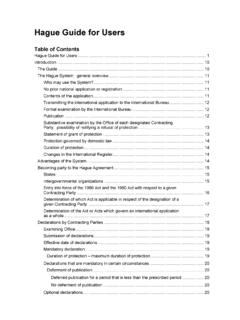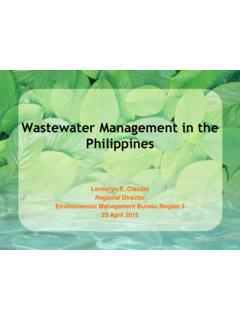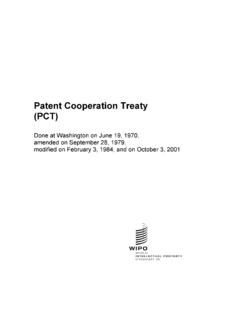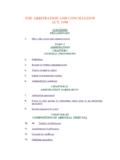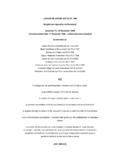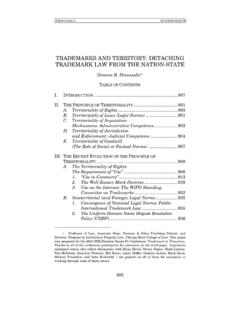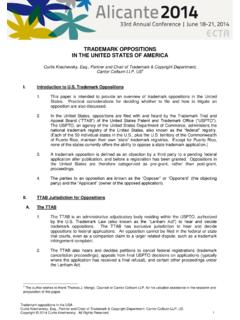Transcription of Trademark Opposition Proceedings in the United …
1 Trademark Opposition Proceedings IN THE United STATESThe Registration Process OverviewThe system for protecting Trademark rights in the United States is based on use of marks and registration of marks. While an entity is not required to register its mark in order to protect it, there are a number of reasons why registration of its mark in the United States Patent and Trademark Office (hereinafter USPTO ) is important, such as: constructive notice to the public of the registrant's claim of ownership of the mark; a legal presumption of the registrant's ownership of the mark and the registrant's exclusive right to use the mark nationwide on or in connection with the goods and/or services listed in the registration; the ability to bring an action concerning the mark in federal court; the use of the registration as a basis to obtain registration in foreign countries.
2 And the ability to file the registration with the Customs Service to prevent importation of infringing foreign we believe it is better to prevent acquisition of rights rather than to bestow rights only later to extinguish them, United States law requires the USPTO to provide an opportunity to qualified third parties to prevent the registration of a mark. The mechanism is known as the Opposition proceeding and it takes place before the USPTO administrative tribunal, the Trademark Trial and Appeal Board (Board). The benefit of such a proceeding is to determine whether an applicant has the right to register, as against any third party, prior to the acquisition of registration rights. Furthermore, the Board is staffed with experts in the Trademark field, all of whom have been examining attorneys, some with experience in private an application for registration is successfully filed, it is reviewed by an examining attorney for statutory compliance (absolute grounds and relative grounds) and for compliance with formal requirements.
3 If the examining attorney is not convinced that the mark is registrable, she will issue a refusal which, if not successfully rebutted, may result in a final refusal that may ultimately be appealed by the applicant to the Board. If the applicant is not successful in convincing the examining attorney or the Board of the registrability of its mark, the application will be considered abandoned. If the examining attorney believes that the mark is registrable, she will allow it to be published in the Trademark Official Gazette. The mark, the goods/services, use dates (if applicable), and other relevant information is published in the 2 Gazette, which is available on the USPTO website. The Gazette is published the mark is not opposed, or the applicant ultimately prevails in an Opposition , the registration certificate will be issued unless the application was filed based on a bona fide intention to use the mark in commerce, in which case a Notice of Allowance will be issued permitting the applicant time in which to submit evidence of use.
4 If the applicant loses the Opposition , its application will be deemed the mark is registered, the owner of the registration must file documents with the USPTO to maintain the registration; otherwise the registration will expire or be cancelled. Interested parties may petition to cancel the registration on the same grounds available in Opposition Proceedings before the fifth anniversary date of the registration. Petitions to cancel filed after five years may not be brought on relative grounds and certain absolute Examination1. Refusals Based on Relative GroundsIf the examining attorney believes that confusion is likely with a registered mark, she will refuse registration and allow the applicant six months in which to rebut the refusal.
5 If there are prior pending marks that, once registered, would become a bar to registration for the mark in the pending application, the examining attorney will so indicate and, if no other issues are present, suspend examination of the later-filed application pending disposition (registration or abandonment) of the earlier-filed factors considered in determining likelihood of confusion include: (Some of these are not considered by the examining attorney because they involve evidence that may only be relevant in an inter partes proceeding , such as facts relating to use of the mark.) The similarity or dissimilarity of the marks in their entireties as to appearance, sound, connotation and commercial impression. The similarity or dissimilarity and nature of the goods or services as described in an application or registration or in connection with which a prior mark is in use.
6 The similarity or dissimilarity of established, likely-to -continue trade channels. The conditions under which and buyers to whom sales are made, "impulse" vs. careful, sophisticated purchasing. The fame of the prior mark (sales, advertising, length of use). The number and nature of similar marks in use on similar goods. The nature and extent of any actual confusion. The length of time during and conditions under which there has been concurrent use without evidence of actual confusion. The variety of goods on which a mark is or is not used (house mark, "family" mark, product mark).3 The market interface between applicant and the owner of a prior mark:(a) a mere "consent" to register or use.(b) agreement provisions designed to preclude confusion, limitations on continued use of the marks by each party.
7 (c) assignment of mark, application, registration and good will of the related business.(d) laches and estoppel attributable to owner of prior mark and indicative of lack of confusion. The extent to which applicant has a right to exclude others from use of its mark on its goods. The extent of potential confusion, , whether de minimis or substantial. Any other established fact probative of the effect of doubts as to registrability are resolved in favor of the registrant. The USPTO considers it important to examine applications on relative grounds because doing so ensures the integrity of the Trademark register and rewards those who avail themselves of the federal registration process. This is important because the register and the database of pending applications provide notice to others that the owner of record has claimed rights in a particular mark for specified goods/services.
8 A federal registration is prima facie evidence that the registrant is the owner of the mark for the goods/services specified. Furthermore, recordation of a federal registration certificate with Customs can prevent infringing articles bearing the mark from entry into the United Refusals Based on Absolute GroundsThe examining attorney may also refuse registration because the mark is descriptive or geographically descriptive (and has not acquired distinctiveness) of the goods/services; is generic of the goods/services; is deceptive as to the goods/services (this includes refusals based on deception as to unregistered well-known marks and unregistered geographical indications) is misdescriptive or geographically misdescriptive of the goods/services; comprises any matter that, as a whole, is functional.
9 Is a surname; consists of or comprises the flag or coat of arms or other insignia of the United States, or of any State or municipality, or of any foreign nation, or any simulation thereof; consists of or comprises immoral, deceptive, or scandalous matter; or matter which may disparage or falsely suggest a connection with persons, living or dead, institutions, beliefs, or national symbols, or bring them into contempt, or disrepute; and4 consists of or comprises a name, portrait, or signature identifying a particular living individual except by his written consent, or the name, signature, or portrait of a deceased President of the United States during the life of his widow, if any, except by the written consent of the Refusals Based on Non-Compliance with Formal RequirementsIn order for an application to receive a filing date in the USPTO, it must include the application fee for at least one class of goods/services; a listing of the goods/service; the name of the applicant; a correspondence address; and a drawing of the mark.
10 These informal applications are rare inasmuch as the electronic application program prompts the applicant to provide this information. There are additional prompts in the electronic system that ensures that other formal requirements, such as the entity type, the basis for application, specimens, signature and other data are entered before , it is the responsibility of the examining attorney to review the application to make certain it is complete and that the identification of goods/services is clear. If the examining attorney finds omissions or requires clarification, she will issue an office action permitting the applicant six months in which to supply the information. As with refusals based on relative and absolute grounds, the examining attorney may issue a final refusal or deem the application abandoned, if the applicant fails to correct the deficiencies, or appeal to the Board in the time allotted.

